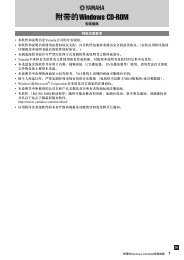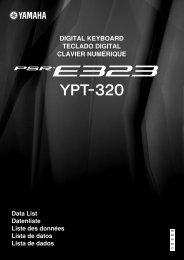You also want an ePaper? Increase the reach of your titles
YUMPU automatically turns print PDFs into web optimized ePapers that Google loves.
MIDI Data Format<br />
1. Channel messages<br />
1.1 Note on / Note off<br />
These messages convey keyboard performance data.<br />
Note-on is transmitted when a note is pressed, and note-off is transmitted<br />
when a note is released.<br />
These messages contain a “note number” which indicates the key that was<br />
played, and a “velocity” which indicates how strongly it was played.<br />
When a note-on of velocity “0” is received, it has the same effect as a noteoff.<br />
Range of note numbers received = 0 (C-2)...60 (C3)...127 (G8)<br />
Velocity range = 1...127 (Velocity is received only for note-on)<br />
When the Multi Part parameter “Rcv NOTE MESSAGE” = OFF, that part will<br />
not receive these messages.<br />
For a drum part*, key-off is not received if the DrumSetup parameter Rcv<br />
NOTE OFF = OFF.<br />
For a drum part, key-on is not received if the DrumSetup parameter Rcv<br />
NOTE ON = OFF.<br />
* Drum Part indicates that the Multi Part parameter PART MODE is “set to<br />
DRUM or DRUMS1...4.”<br />
1.2 Control changes<br />
These messages control volume or pan etc.<br />
Their functions are differentiated by the control number (Ctrl#).<br />
If the Multi Part parameter Rcv CONTROL CHANGE = OFF, that part will not<br />
receive control changes.<br />
1.2.1 Bank Select<br />
This message selects the voice bank.<br />
The voice bank is selected by the combination of two control change messages:<br />
MSB and LSB.<br />
The function of the MSB and LSB will differ depending on the sound module<br />
mode.<br />
In the case of “XG,” the MSB value will specify the major division of voices,<br />
and the LSB value will specify the detailed division.<br />
In the case of “TG300B,” the LSB value is fixed, and only the MSB value will<br />
specify the detailed voice division.<br />
Control# Parameter Data Range<br />
0 Bank Select MSB 0...127<br />
32 Bank Select LSB 0...127<br />
The Bank Select data will be processed only after a Program Change is<br />
received, and then voice bank will change at that time.<br />
If you wish to change the voice bank as well as the voice, you must transmit<br />
Bank Select and Program Change messages as a set, in the order of Bank<br />
Select MSB, LSB, and Program Change.<br />
1.2.2 Modulation<br />
This message is used primarily to control the depth of vibrato, but the depth<br />
of the following 7 types of effect can be controlled.<br />
The effect of this message can be changed by the following parameters.<br />
• Multi Part Parameter<br />
1. MW PITCH CONTROL<br />
2. MW FILTER CONTROL<br />
3. MW AMPLITUDE CONTROL<br />
4. MW LFO PMOD DEPTH<br />
5. MW LFO FMOD DEPTH<br />
6. MW LFO AMOD DEPTH<br />
• Effect1 Parameter<br />
7. MW VARIATION CONTROL DEPTH<br />
(Valid when Variation Effect is assigned to a part as Insertion)<br />
By default, an LFO Pitch Modulation (PMOD) effect will apply.<br />
Control# Parameter Data Range<br />
1 Modulation 0...127<br />
If the Multi Part parameter Rcv MODULATION = OFF, that part will not<br />
receive Modulation.<br />
If the receive channel is a drum part, effects 5 and 6 will not apply.<br />
68<br />
1.2.3 Portamento Time<br />
This message controls the degree of Portamento (refer to 1.2.9).<br />
Control# Parameter Data Range<br />
5 Portamento Time 0...127<br />
When Portamento (control number 065) is ON, this regulates the speed of<br />
the pitch change.<br />
A value of 0 is the shortest portamento time, and 127 is the longest portamento<br />
time.<br />
If the receive channel is a drum part, Portamento Time is not received.<br />
1.2.4 Data Entry<br />
This message sets the value of the parameter which was specified by RPN<br />
MSB/LSB (see 1.2.22) and NRPN MSB/LSB (see 1.2.21).<br />
Control# Parameter Data Range<br />
6 Data Entry MSB 0...127<br />
38 Data Entry LSB 0...127<br />
1.2.5 Main Volume<br />
This message controls the volume of each part.<br />
This is used to adjust the volume balance between parts.<br />
Control# Parameter Data Range<br />
7 Main Volume 0...127<br />
When the Multi Part parameter Rcv VOLUME = OFF, that part will not receive<br />
Main Volume.<br />
With a value of 0 there will be no sound, and a value of 127 will be the maximum<br />
volume.<br />
1.2.6 Panpot<br />
This message control the panning (stereo location) of each part.<br />
This will be the location of the sound when heard in stereo.<br />
Control# Parameter Data Range<br />
10 Pan 0...64...127<br />
When the Multi Part parameter Rcv PAN = OFF, that part will not receive<br />
Panpot.<br />
0 is left, 64 is center, and 127 is right.<br />
1.2.7 Expression<br />
This message controls expression (dynamics within a musical line) for each<br />
part.<br />
It is used to create volume changes during a song.<br />
Control# Parameter Data Range<br />
11 Expression 0...127<br />
If the Multi Part parameter Rcv EXPRESSION = OFF, that part will not receive<br />
Expression.<br />
With a value of 0 there will be no sound, and with a value of 127 the volume<br />
will be maximum.<br />
1.2.8 Hold1<br />
This message controls sustain pedal on/off.<br />
The notes that are sounding while the pedal is pressed will be sustained.<br />
Control# Parameter Data Range<br />
64 Hold1 0...63,64...127<br />
(OFF, ON)<br />
For data of 0...63 the sustain pedal will be OFF (released), and for data of<br />
64...127 it will be on (pressed).<br />
When this is ON, currently-sounding notes will continue to sound even if<br />
note-off messages are received.<br />
If the Multi Part parameter Rcv HOLD1 = OFF, that part will not receive<br />
Hold1.




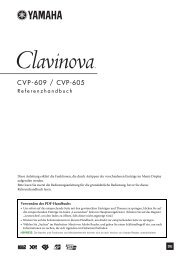

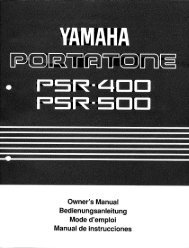

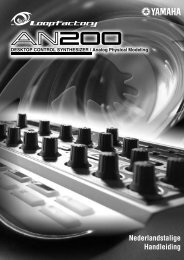
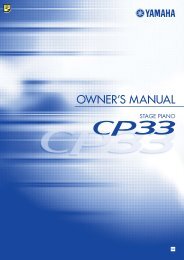


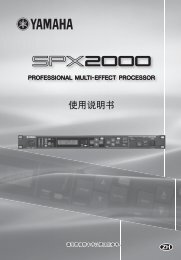
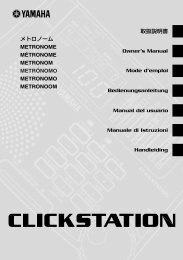
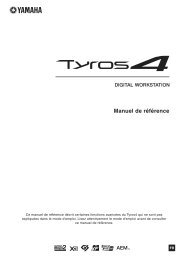
![Premere il pulsante [SONG] - Yamaha](https://img.yumpu.com/50419553/1/184x260/premere-il-pulsante-song-yamaha.jpg?quality=85)
